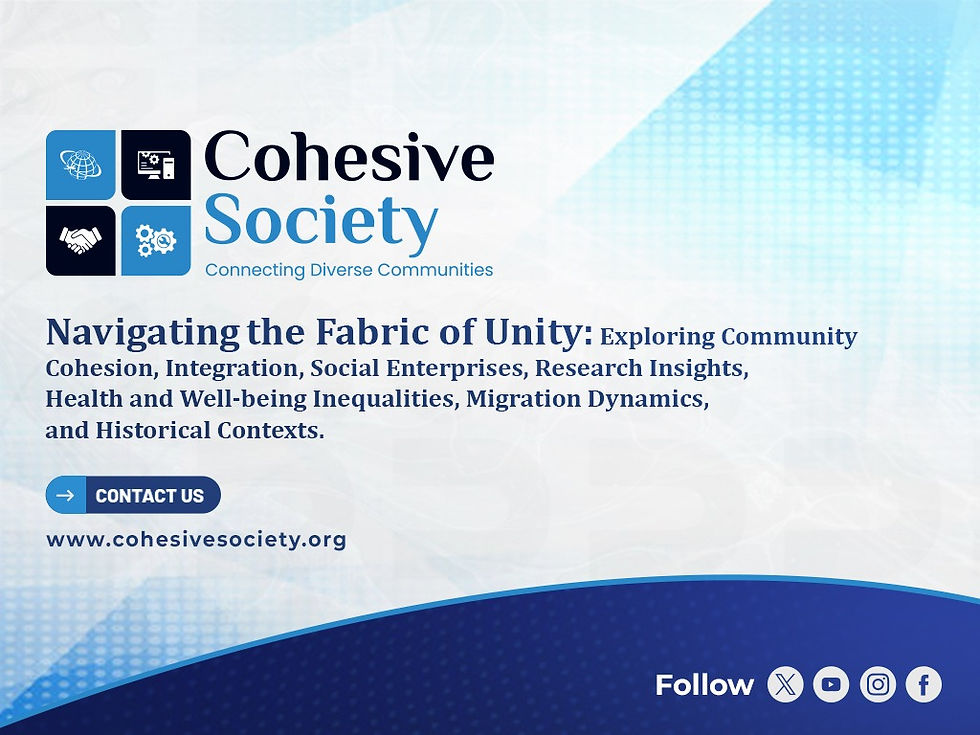Autism in the BAME Communities in the United Kingdom
- Cohesive Society

- May 31, 2023
- 4 min read
Updated: Mar 29, 2024

Introduction
Autism, a complex neurodevelopmental disorder, affects individuals regardless of their race, ethnicity, or cultural background. However, within the BAME (Black, Asian, and Minority Ethnic) communities in the United Kingdom, autism remains a subject shrouded in taboo and stigma. The lack of awareness, cultural beliefs, language barriers, and limited access to diagnostic services often hinder early detection and intervention for children with autism. In this blog, we will shed light on the challenges faced by BAME communities, the significance of overcoming cultural barriers, the need for parental empowerment, possible causes of autism, the role of the government and health services, and tangible suggestions for addressing the issue.
Taboo and Diagnosis Issues
Autism is still surrounded by myths and misconceptions in many BAME communities, leading to a reluctance to discuss and acknowledge the condition. This cultural taboo often results in delayed diagnosis and missed opportunities for early intervention, which are crucial for maximizing developmental outcomes. Language barriers and limited access to culturally sensitive diagnostic services further compound the problem. To address this issue, it is imperative to promote autism awareness campaigns tailored to BAME communities, emphasizing the importance of early diagnosis and debunking prevalent myths.
Parental Suppression and Children's Suffering
In some BAME communities, parents may suppress or deny the signs of autism due to the fear of social stigma and societal pressure. This denial delays access to appropriate support and intervention, leaving children to suffer silently. It is crucial to create a supportive environment that encourages open discussions about autism within families and communities. Empowering parents through education and peer support can play a pivotal role in breaking down the barriers of denial and suppression.
Causes of Autism
The exact causes of autism are still not fully understood, but research suggests that a combination of genetic and environmental factors contribute to its development. Studies have shown that certain genetic variations are more prevalent in individuals with autism. Additionally, prenatal factors such as maternal infections, exposure to environmental toxins, and advanced parental age may also increase the risk. It is important to dispel the misconception that autism is solely caused by external factors and instead foster understanding that it is a complex interplay of genetic and environmental influences.
Government and Health Services Support
The government and health services in the United Kingdom have a crucial role to play in addressing the challenges faced by BAME communities regarding autism. Firstly, there is a need for culturally sensitive training programs for healthcare professionals to improve their understanding of different cultural perspectives on autism. This would enable them to provide more effective support and diagnosis. Secondly, increased funding for diagnostic services in underserved areas and promoting inclusive educational opportunities for children with autism can ensure equitable access to care and support.
Extending Research on Autism
Further research is needed to gain a deeper understanding of autism within BAME communities. This research should focus on examining the cultural factors that influence perception, acceptance, and access to services. It is essential to involve community members, healthcare professionals, and researchers from diverse backgrounds to conduct culturally appropriate studies. Additionally, research should explore effective strategies for early detection, intervention, and support tailored specifically to BAME communities.
Tangible Suggestions for Tackling the Issue
a) Culturally Sensitive Awareness Campaigns: Develop and disseminate autism awareness campaigns that are specifically tailored to different BAME communities, addressing cultural beliefs and debunking myths.
b) Training for Healthcare Professionals: Provide comprehensive training programs for healthcare professionals to enhance their cultural competence and understanding of autism within diverse communities.
c) Community Outreach Programs: Collaborate with community leaders and organizations to organize outreach programs, workshops, and support groups that provide information, resources, and support for parents and caregivers.
d) Culturally Adapted Diagnostic Services: Establish diagnostic services that are culturally adapted and accessible to BAME communities, ensuring language support and culturally appropriate assessment tools.
e) Collaboration and Partnership: Foster collaboration between community organizations, schools, healthcare providers, and government agencies to create a holistic support network for individuals with autism and their families.
Conclusion
Autism in the BAME communities in the United Kingdom requires urgent attention. By breaking the taboo, addressing diagnosis issues, empowering parents, and promoting culturally sensitive support, we can improve the lives of individuals with autism. It is vital for the government and health services to step up efforts, provide accessible services, and allocate sufficient resources to ensure equitable access to diagnosis, intervention, and support. With a collective effort, we can foster a society that embraces diversity, understanding, and inclusivity for individuals with autism across all communities.
Bibliography:
Baron-Cohen, S., Scott, F.J., Allison, C., Williams, J., Bolton, P., & Matthews, F.E. (2009). Prevalence of autism-spectrum conditions: UK school-based population study. The British Journal of Psychiatry, 194(6), 500-509.
Brugha, T.S., Spiers, N., Bankart, J., Cooper, S.A., McManus, S., Scott, F.J., ... & Meltzer, H. (2016). Epidemiology of autism in adults across age groups and ability levels. The British Journal of Psychiatry, 209(6), 498-503.
Giarelli, E., Wiggins, L.D., Rice, C.E., Levy, S.E., Kirby, R.S., Pinto-Martin, J., & Mandell, D.S. (2010). Sex differences in the evaluation and diagnosis of autism spectrum disorders among children. Disability and Health Journal, 3(2), 107-116.
Hsia, Y., Neogi, S.B., Whitehouse, A.J.O., & Maybery, M.T. (2019). Moderators of the pathway from prenatal maternal affect to child autism spectrum disorder-related traits: A systematic review. Autism Research, 12(11), 1575-1592.
National Institute for Health and Care Excellence. (2011). Autism: recognition, referral, diagnosis and management of adults on the autism spectrum. Retrieved from https://www.nice.org.uk/guidance/cg142
Organ, B., & Collins, S. (2015). The impact of the diagnostic label of autism on stigma and stereotyped perceptions of children with autism spectrum disorders. Journal of Autism and Developmental Disorders, 45(3), 780-794.



Comments